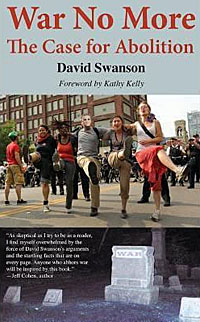 By David Swanson
By David Swanson
Urge the ending of war these days and you’ll very quickly hear two words: “Hitler” and “Rwanda.” While World War II killed some 70 million people, it’s the killing of some 6 to 10 million (depending on who’s included) that carries the name Holocaust. Never mind that the United States and its allies refused to help those people before the war or to halt the war to save them or to prioritize helping them when the war ended — or even to refrain from letting the Pentagon hire some of their killers. Never mind that saving the Jews didn’t become a purpose for WWII until long after the war was over. Propose eliminating war from the world and your ears will ring with the name that Hillary Clinton calls Vladimir Putin and that John Kerry calls Bashar al Assad.
Get past Hitler, and shouts of “We must prevent another Rwanda!” will stop you in your tracks, unless your education has overcome a nearly universal myth that runs as follows. In 1994, a bunch of irrational Africans in Rwanda developed a plan to eliminate a tribal minority and carried out their plan to the extent of slaughtering over a million people from that tribe — for purely irrational motivations of tribal hatred. The U.S. government had been busy doing good deeds elsewhere and not paying enough attention until it was too late. The United Nations knew what was happening but refused to act, due to its being a large bureaucracy inhabited by weak-willed non-Americans. But, thanks to U.S. efforts, the criminals were prosecuted, refugees were allowed to return, and democracy and European enlightenment were brought belatedly to the dark valleys of Rwanda.
Something like this myth is in the minds of those who shout for attacks on Libya or Syria or the Ukraine under the banner of “Not another Rwanda!” The thinking would be hopelessly sloppy even if based on facts. The idea that SOMETHING was needed in Rwanda morphs into the idea that heavy bombing was needed in Rwanda which slides effortlessly into the idea that heavy bombing is needed in Libya. The result is the destruction of Libya. But the argument is not for those who pay attention to what was happening in and around Rwanda before or since 1994. It’s a momentary argument meant to apply only to a moment. Never mind why Gadaffi was transformed from a Western ally into a Western enemy, and never mind what the war left behind. Pay no attention to how World War I was ended and how many wise observers predicted World War II at that time. The point is that a Rwanda was going to happen in Libya (unless you look at the facts too closely) and it did not happen. Case closed. Next victim.
Edward Herman highly recommends a book by Robin Philpot called Rwanda and the New Scramble for Africa: From Tragedy to Useful Imperial Fiction, and so do I. Philpot opens with U.N. Secretary General Boutros Boutros-Ghali’s comment that “the genocide in Rwanda was one hundred percent the responsibility of the Americans!” How could that be? Americans are not to blame for how things are in backward parts of the world prior to their “interventions.” Surely Mr. double Boutros has got his chronology wrong. Too much time spent in those U.N. offices with foreign bureaucrats no doubt. And yet, the facts — not disputed claims but universally agreed upon facts that are simply deemphasized by many — say otherwise.
The United States backed an invasion of Rwanda on October 1, 1990, by a Ugandan army led by U.S.-trained killers, and supported their attack on Rwanda for three-and-a-half years. The Rwandan government, in response, did not follow the model of the U.S. internment of Japanese during World War II, or of U.S. treatment of Muslims for the past 12 years. Nor did it fabricate the idea of traitors in its midst, as the invading army in fact had 36 active cells of collaborators in Rwanda. But the Rwandan government did arrest 8,000 people and hold them for a few days to six-months. Africa Watch (later Human Rights Watch/Africa) declared this a serious violation of human rights, but had nothing to say about the invasion and war. Alison Des Forges of Africa Watch explained that good human rights groups “do not examine the issue of who makes war. We see war as an evil and we try to prevent the existence of war from being an excuse for massive human rights violations.”
The war killed many people, whether or not those killings qualified as human rights violations. People fled the invaders, creating a huge refugee crisis, ruined agriculture, wrecked economy, and shattered society. The United States and the West armed the warmakers and applied additional pressure through the World Bank, IMF, and USAID. And among the results of the war was increased hostility between Hutus and Tutsis. Eventually the government would topple. First would come the mass slaughter known as the Rwandan Genocide. And before that would come the murder of two presidents. At that point, in April 1994, Rwanda was in chaos almost on the level of post-liberation Iraq or Libya.
One way to have prevented the slaughter would have been to not support the war. Another way to have prevented the slaughter would have been to not support the assassination of the presidents of Rwanda and Burundi on April 6, 1994. The evidence points strongly to the U.S.-backed and U.S.-trained war-maker Paul Kagame — now president of Rwanda — as the guilty party. While there is no dispute that the presidents’ plane was shot down, human rights groups and international bodies have simply referred in passing to a “plane crash” and refused to investigate.
A third way to have prevented the slaughter, which began immediately upon news of the presidents’ assassinations, might have been to send in U.N. peacekeepers (not the same thing as Hellfire missiles, be it noted), but that was not what Washington wanted, and the U.S. government worked against it. What the Clinton administration was after was putting Kagame in power. Thus the resistance to calling the slaughter a “genocide” (and sending in the U.N.) until blaming that crime on the Hutu-dominated government became seen as useful. The evidence assembled by Philpot suggests that the “genocide” was not so much planned as erupted following the shooting down of the plane, was politically motivated rather than simply ethnic, and was not nearly as one-sided as generally assumed.
Moreover, the killing of civilians in Rwanda has continued ever since, although the killing has been much more heavy in neighboring Congo, where Kagame’s government took the war — with U.S. aid and weapons and troops — and bombed refugee camps killing some million people. The excuse for going into the Congo has been the hunt for Rwandan war criminals. The real motivation has been Western control and profits. War in the Congo has continued to this day, leaving some 6 million dead — the worst killing since the 70 million of WWII. And yet nobody ever says “We must prevent another Congo!”









8 Responses
Thanks for writing this.
Thanks for writing this. Something similar to what you describe in this paragraph is being repeated now in Rwanda’s neighbor Burundi, where the US wants to remove President Pierre Nkurunziza:
“Africa Watch (later Human Rights Watch/Africa) declared this a serious violation of human rights, but had nothing to say about the invasion and war. Alison Des Forges of Africa Watch explained that good human rights groups “do not examine the issue of who makes war. We see war as an evil and we try to prevent the existence of war from being an excuse for massive human rights violations.”
I congratulate you for this work. I wish it to enlighten people who still believe the official narrative! thanks a lot!
Good piece. But it should be noted that the mass killings come to be known as the Rwandan Genocide were ramped up not just on the double presidential assassination the Hutu (majoritarian) heads of State), but, and primarily, on and by the final RPF military offense that ultimately seized State power in Rwanda–power it still holds unchallenged today.
As a survivor of this horrible genocide and former employee in president Habyarimana office, I maintain that the Rwandan genocide has never been planned since no tangible evidence has been found by any independent court. And again, the failure for international intervention should solery be imputed to to President Kagame and the US who did their best to dissuade the UN Security Council into sending peacekeepers only 3 weeks after the genocide had started.
Yes.T’s obvious that the killings in Rwanda in 1994 was more politically motivated than ethnically, and totally US-backed rather than planned by the Interim Rwandan Government. The one who launched the war as a proxy or otherwise is the most responsible for the slaughtering of the Rwandan People.
The author (whoever that is) get some of it right and not having the Philpot book I do not know if he got the book right. But if he did then the book leaves out that most of the killings were committed by the invading Ugandan Army-RPF forces with the help of US force that were directly involved (US forces were seen at Kagame’s HQ 2 days before the RPF attacked on April 6 1994, and US C130 Hercules were observed dropping men and supplies to the RPF forces after that. As well, General Dallaire assisted the RPF in building up their forces for their final attack in violation of his neutral role and the Belgian UN forces fought on the side of the RPF and took part in the final attack. If Philpot does not include these facts in his book, that is strange because I sent him these facts some time ago. It is also likely that the Belgian forces were involved in the shoot down of the plane and their role and the role of Dallaire in the murder of the prime minister Agathe is darker than people imagine. The “slaughter” of innocents was begun by the RPF force the night and erarly morning of April 6/7th and never stopped as his forces killed every Hutu in their path then claimed the bodies were of Tutsis. There was no mass slaughter of Tutsis except in local villages where tensions stoked by the war came to a head ias the Tutsi RPF force advanced into those areas slaughtering all the Hutus and local Tutsis, feeling betrayed reacted. But there was also a lot of banditry. Nor is it mentioned that video was presented in the Military II trial of UN officers giving submachine guns to Interahamwe officials in Kigali supporting the other evidence that the RPF had infiltrated that organisation and killed people at roadblocks to discredit the government. Nor does he mention that statements from RPF officers were filed in the same trial stating that eg at the stadiums in Byumba and Gitarama, when RPF officers told Kagame that there were thousands of Hutu refugees located in them and was asked what to do -he gave an order of 3 simple words: “Kill them all.” If these things are not in Philpot’s book, that is too bad -he should have paid more attention to defence counsel who have the evidence. Christopher Black, Lead Counsel, General Ndindiliyimana, Military II Trial, ICTR.
The Polish President and Prime Minister’s (Twin Brothers) light plane was shot down as well with survivors reportedly shot on the ground so #Brezinski could get a Government more aggressive towards Moscow – the Media reported this as an accident and there was no investigation.